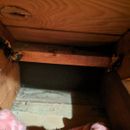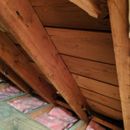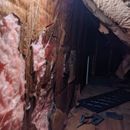Insulation knee wall
Hello.
I am insulating the sloped ceiling in the knee wall. The house doesn’t have eaves or any soffit vents that I can see. When I pull back the insulation where the floor meets the roofline there is no daylight at all. Should I use baffles still before I put the insulation on the ceiling?
Thank you!
GBA Detail Library
A collection of one thousand construction details organized by climate and house part












Replies
Deleted
What's your plan for this? To keep the insulation at the knee walls and attic floors? Or insulate under the roof sheathing? Because my understanding is those are 2 different (and mutually exclusive) options, and you say "insulating the sloped ceiling".
I meant the roof sheathing between the rafters. I ended up using the vent baffles because I already had them. The knee wall itself is already insulated as is the floor. Although it is old and poorly done. The girls room is colder and I'm trying to get it a bit warmer. This is a cape cod and I'm in zone 5.
I need to do some air sealing. I pulled back the floor insulation when I was in there and the plaster is pretty tight on that side as there is no light or fan in the room below. Other rooms I'll need to investigate more.
Hi Pennstater2005.
The short answer is that if the roof is not vented, than you don't veen vent baffles. However, this is not an easy job to do well. I recommend you read these articles to get your head wrapped around your options and what needs to be done:
All About Attic Venting
Insulating Behind Kneewalls
How to Build an Insulated Cathedral Ceiling
Thanks Brian. I read the kneewall article. I have gave vents with a turbine up top. No soffit so I’m assuming no lower ventilation. The attic was previously insulated on the knee wall itself, the floor, and some of the rafters. Kind of hit and miss. The insulation is obviously very old and crumbling. From the knee wall article I believe I should focus insulation to the rafters. It’s the air sealing that confuses me when I’m actually in the attic looking at where the rafters meet the attic floor.
>"I have gave vents with a turbine up top. No soffit so I’m assuming no lower ventilation. "
The turbine up top is an actively bad idea, since it can depressurize the house enough to pull excessive conditioned space air into the attics.
When going for an unvented attic space the air-tightness where the rafters go over the exterior walls is often a weak point, and often hard to reach in an retrofit. This is one location where being a bit generous with spray polyurethane insulation can be rationalized in a retrofit (even for the less-green DIY closed cell foam kits.) But if there is going to be a professional installing the foam, hold out for HFO blown goods rather than the industry standard (but now contraband in Kigali Amendment signatory countries) HFC245fa blown foams.
https://materialspalette.org/wp-content/uploads/2018/08/CSMP-Insulation_090919-01.png
Sorry, gable vents :)
Thanks Dana. Never knew that about the turbine.
Edited to add: I'll check more into insulating the weak point you're talking about.
Can’t believe it’s been 2 years since I posted this. I ended up using the baffles as they were so cheap and if any air was flowing it would have a place to go. I am working this year on the upper part of the knee wall attic. That is a pain to access.
I’m going to remove the old, dirty insulation and replace with r38. It’s amazing to see the snow stays on the portion that I’ve insulated and melts quickly above where the old insulation is but not working.